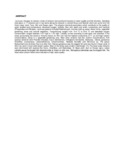| dc.identifier.citation | Sigana, DO., ]Gichuki, N N & Bart, H (2013). The effects of riparian land use on water quality and fish species composition in the headwater streams of Tana, Athi and Ewaso Ngiro Rivers within Central Kenya. Fifth international conference of the pan african fish and fisheries association (PAFFA5) held at Bujumbura, Burundi on 16th -20th september 2013. (diversity, conservation and sustainable management book of abstracts) | en_US |
| dc.description.abstract | Land use changes on riparian zones of streams have profound impacts on water quality and fish
diversity. Sampling took place in 17 streams and in two da
ms along the streams in central Kenya and
Nairobi which join up to form the three major rivers Tana, Athi and Ewaso ngiro. The physico
-
chemical parameters which contribute to the quality of water studied were temperature, dissolved
oxygen, turbidity, flow
rate, depth and width, conductivity and nutrients (Phosphates and Nitrates).
Land use patterns included National park, ranches, built
-
up areas, flower farms, vegetable gardening
areas and natural vegetation. Temperatures ranged from 13.4 °C to 22.4 °C and
dissolved oxygen
concentration ranged between 4.47 mg/l to 1.76 mg/l. Turbidity varied according to soil types and
activities in the areas surrounding the streams. Kinania stream on Athi river had the highest
conductivity of 71
μ
s and high nutrient concentrations, being in a vegetable gardening area. Most other
streams had low nutrient concentrations. Fish species obtained were
Poecilia reticulata
,
Garra
dembeensis
,
Chiloglanis brevibarbis
,
Barbus
sp.,
Clarias gariepinus
Amphiliu
s uranoscopus
,
Labeo
cylindricus
,
Oreochromis
sp.,
Neobola fluviatilis
and
Mormyrus
sp. The genus
Barbus
had more
diversity than any other fish.
Clarias gariepinus
was the biggest fish and was found in lower parts of
Athi river and in more turbid steam wat
ers. Most of the fishes were small in total length (TL).The head
water streams were dominated with species like
Garra, Amphilius
, and
Neobola
sp. At Hippo point
dam on Ewaso ngiro,
Labeo cylindricus
was the largest fish obtained while at Karen on Athi rive
r,
Micropterus salmoides
was the largest fish. The head water stream fishes were indicators of high
water quality | en_US |

